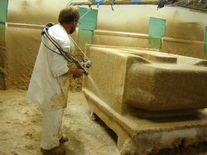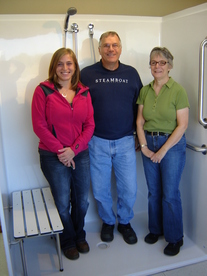|
In this issue:
- Industrial stormwater sampler
- Green Chemistry in action: Salo Manufacturing
- Burning used oil for heat
- Online emission inventory reporting coming soon
- Funding opportunities
|
|
 |
By Tom
Jablonski
To protect Minnesota’s precious
water resources, manufacturers and other facilities regulated by Minnesota’s updated
industrial stormwater permit are required to monitor stormwater runoff from their
site via quarterly sampling. The purpose of the monitoring is to ensure
best management practices are preventing pollution from running off-site.
Four quarterly samples are
required over a one year period beginning one year after permit coverage. The results of these samples are then averaged and compared to sector-specific benchmark
values listed in the permit. Results that exceed the benchmark value will
require modification in best management practices and additional sampling.
Suggestions for implementing an
effective stormwater monitoring program:
-
Read your
permit and know when to sample.
-
Review your
stormwater pollution prevention plan and assure monitoring locations provide
representative samples of the stormwater that runs off your site during a rain or
run-off event.
-
Contact a
laboratory for appropriate sample bottles and shipping kits.
-
Read the Monitoring Guidance Manual, view videos on
collecting samples and locate monitoring sites, and get more information on
evaluating and submitting sample results on the Minnesota Pollution Control
Agency’s Industrial Stormwater webpages.
-
Revisit No-Exposure exclusion opportunities to potentially save time and
money.
Contact the SBEAP helpline at
651-282-6143 with questions.
|
By Mark
Snyder
The MPCA awarded a Green
Chemistry and Design Demonstration Project grant to Salo Manufacturing, Inc., in
April 2011. Salo currently manufactures shower enclosures and bathtubs using a
styrene-based resin. The project was
developed to test potentially cost-effective low-styrene and styrene-free alternative
resins that would meet structural and cosmetic requirements and result in
reduced air emissions, a healthier work environment for employees, and a greener
product for consumers.
Salo hired a Minnesota Technical
Assistance Program (MnTAP) intern to perform a survey of environmentally
preferable manufacturing materials. While no styrene-free gel coats were available,
the intern did test a LEED-eligible recycled-content gel coat, but it would not
have significantly reduced air emissions. A styrene-free (green) resin was
also tested that could potentially reduce emissions by 10,800
pounds annually.
|
|
 |
However, units with the green resin were significantly more
expensive and were unable to pass a weight deflection test. The deflection test
failure may have been due to poor cross-linking during resin polymerization; a
different catalyst may improve performance. Salo intends to monitor market and
regulatory conditions for styrene and will revisit the green resin when
circumstances are more favorable.
The MnTAP intern also researched acetone
alternatives for equipment cleaning and identified a 100 percent biodegradable, green
cleaner called Acrastrip®. Salo has
already replaced 8,000 pounds of acetone per year with Acrastrip® thus avoiding
1.5 barrels of hazardous waste and eliminating 3,570 pounds of VOC emissions. Other
benefits include cost savings from water dilution (1:4 ratios), reclamation through
settling, and a higher flashpoint (less evaporative loss). In all, using Acrastrip®
will save Salo $1,688 per year.
Finally, pre-manufactured
compressible foam slabs were found as an alternative to their
isocyanate-containing rigid foam shower base. Using the foam slabs will
eliminate isocyanate emissions and reduce base application time from 90 to 15
minutes; removing a process bottleneck and saving nearly $3,000 annually in
material and labor costs.
By Aneka Swanson
If you
are thinking about burning used oil for comfort heat this winter, here are a
few things to consider. Used
oil can be recycled into usable oil. If your used oil is being rerefined into
usable oil, this reuse of the product is preferred to burning. However, if your
waste hauler burns your used oil for energy, you may want to burn it yourself to
offset some oil disposal and winter heating costs.
Burning
used oil is regulated by the Minnesota Pollution Control Agency (MPCA) and the
U.S. Environmental Protection Agency (EPA). You may burn used oil for comfort
heat as long as:
-
the oil is generated on site or by do-it-yourselfers,
-
your burner is specifically designed for oil burning and rated at less
than 420,000 BTUs per hour, and
- flue gases are vented to the outdoors.
Most
businesses need at least 500 gallons of used oil available each year to make it
worthwhile, depending on the costs of equipment and other fuels. Prices for a
basic used oil space heater start at about $2,000.
Your
business is probably a good source of used oil if you perform oil changes or
repair your own machines. Do-it-yourselfers who change their own automotive
engine oil are another acceptable source. It is a good idea to have them sign a
sheet when they drop off used oil to hold them accountable for the purity of
the oil they bring you. This way you are less likely to contaminate your used
oil supply with unacceptable fluids such as antifreeze, fuels, or solvents. You
cannot mix used oil with these fluids or hazardous wastes.
Report
used oil on your hazardous waste license if required by your county, and ensure
that you are following proper storage requirements for used oil. See MPCA
hazardous waste fact sheet #4.30 “Managing Used Oil”.
You
may burn used oil from other businesses if the oil is tested and found to be ‘”on-spec.”
See MPCA waste fact sheet #4.32 “Burning Used Oil”, for detailed information
about requirements and reporting.
Be
sure to consider local fire and building codes as you make your decision.
Starting in January 2012,
companies with Air Quality Option C and Option D Registration Permits will
submit annual emissions inventory online. This reporting system, which is part of a larger effort to consolidate
air quality information, is already in place for larger facilities. Air Quality
Option B and Non-metallic General Permit holders will still have paper forms
for one more year.
As part of this system,
responsible officials and preparers will need to set up an individual online
account. For responsible officials, once
your account is set up, you will be asked to submit a form with your official
signature. The MPCA will use this form
to connect your individual account with your online company information.
To help companies
understand the new reporting system, webcasts and written instructions will be
provided. For more information visit here.
MPCA begins accepting applications for $350,000 in clean
diesel grant funding
Beginning Nov. 14, the MPCA will be seeking applicants to use its federal
Diesel Emission Reduction Act (DERA) grant funding to improve a wide range of
fleets. Applications must be received by Dec. 22, 2011, and projects must
be completed by Aug. 31, 2012.
The MPCA’s new target will be public and private on-road and off-road
diesel fleets older than 2007 that operate in Minnesota, with preference given
to those operating in the seven-county Twin Cities metro area. Focus
remains on the Twin Cities because air quality there is close to exceeding the
national air quality health standards for fine particles and ozone.
“Diesel engines are essential due to their longevity and efficiency, but
older diesels pollute significantly more than other vehicles in terms of fine
particle pollution,” MPCA Assistant Commissioner David Thornton said. “Overall the air quality is improving in the state, but more medical studies
showing health problems at lower levels of air pollution prompted the EPA to
make standards more strict in recent years,” he explained.
The current Request for Propossl (RFP) will fund EPA-approved technologies,
including idle reduction, emission controls, hybrid replacement and engine
re-powers. Vehicle and equipment examples include on-road class 5 (16,000
lb. gross vehicle weight) or larger delivery trucks, off-road construction
equipment, generators of 100-300 horsepower, and refrigeration units for
delivery trucks.
The minimum award is $10,000 and the maximum award is $150,000. Vehicles and equipment must be in working order to be eligible for grant
funding and no work can begin until a contract agreement is approved by the
MPCA. For a copy of the Request for Proposal (RFP), contact Martina
Cameron at contracts.pca@state.mn.us
or at 651-757-2259. Applicants will need to give an email
address to receive the RFP application and supporting materials
electronically. The email subject line should read: “CR5220, Clean Diesel
RFP.” More information can be found online on the MPCA’s Grants/Financial
Assistance for Clean Diesel Projects page.
|